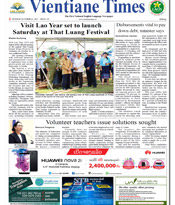COLUMNISTS: LOOKING BACK- Reclaiming ‘Intsik’
As a student in Madrid in the early 1880s, Jose Rizal complained about rude children mistaking him for a Chinese. He was also mistaken for a Japanese in a Paris museum, but Rizal rode along and explained the Japanese art on display, until he was asked to translate a text in Kanji. Stumped, Rizal made a quick exit. These experiences made him address Filipinas, his motherland: “Woe to you, nobody knows of you.”
I shared Rizal’s experience abroad a century later. Rome shopkeepers and waiters addressed me in Spanish rather than in Italian, because I looked “Sud-Americano.” In Malaysia and Indonesia, I was mistaken for a Chinese. Not a bad guess, since I am actually 1/8 Chinese. But in the Philippines, I won’t qualify as Tsinoy.
.


..
Fresh off the boat from 19th-century Fujian, my paternal great-grandfather was a Chinaman with a ponytail, vaguely remembered by descendants as “Un Ah” (Mr. Un). The uncommon surname Un isn’t helpful for genealogical research, because my Tsinoy friends think it a misspelling of Uy, Ong, or Ang. My great-grandmother from Guagua had children with a succession of three Chinamen: Mr. Un and two dudes, both surnamed Ong, now lost to family history and memory.
My grandmother was more than half-Chinese, but raised her sons as naughty Kapampangans who extorted candy, vinegar, or butter from the neighborhood Chinese shopkeeper. Growing up, I overheard the elders refer to ethnic Chinese, with a smirk, as “isik.” As a boy, I confused “intsek” with “insect” and thought my relatives were mean. Intsik, from the Hokkien “in-chek” (his uncle), was not a bad word. That’s why multiracial Singapore has “Encik Tan,” a halal food chain, and Binondo has Meisic St., which comes from the Tagalog “me-isic” or “may intsik” (there are Chinese) or “ma-intsik” (there are many Chinese).
.
Intsik got a bad rap from the Tagalog childhood rhyme “intsik beho tulo laway,” used to taunt anyone who looked even remotely Chinese. “Beho,” from the Spanish “Viejo” (old), renders the phrase as “Drooling old Chinaman,” a reference to the “parokyanos” of Binondo opium dens of old who drooled on themselves in their stupor. In “Noli me tangere,” the jolly Kapitan Tiago of Chapter One deteriorates in the Epilogue into an addict who frequents a house marked Fumadero Publico de Anfion (Public Opium Smoking Den).
I’m told Intsik is not as bad as Tsekwa, from the innocent Hokkien “chek goa kang” (his uncle, I work), eventually colored by the Visayan rhyme “Intsik gwakang kaon kalibang” (Chinese eat sh—t). I asked my good friend Jobers Bersales of the University of San Carlos-Cebu to confirm the translation I found on the net, and he replied that “kwakang” is a nonsense word. The Cebuano version is “insik kwakang baboy tikangkang” (Chinaman likes a pig with legs spread wide). Bersales would neither confirm nor deny that it could refer to lechon Cebu or sodomy. I leave that to the imagination of our academics.
Terms for Chinese that populate Spanish archival sources include Chino, Sangley, and Mestizo de Sangley. Chino in modern times became Tsino, a Chinese. When the Chino intermarried, his half-breed children became Chinese mestizos or the modern Tsinoy. Another term is Sangley, from the Chinese “seng-li” (merchant traveler or frequent visitor), that’s why we have Sangley Point, Cavite today, which is believed to have served as a refuge for the pirate Limahong in the 16th century. Mestizo de Sangley was a person of mixed breed: Chinese and something else.
If I were to choose between the historical Intsik over the contemporary Tsinoy, I would choose the older word, including its offensive meanings. Intsik should be reclaimed by Tsinoys, like other insulting colonial terms such as Indio, Igorot, and Moro that have since been reclaimed as a badge of courage rather than a reminder of a racial slur. Didn’t Rizal and his barkada refer to themselves in jest as “Inchics?” Didn’t Rizal and his barkada in 1889 reclaim the derogatory term Indio and call themselves the Yndios Bravos (Brave Indians)? Didn’t Nur Misuari in 1972 reclaim the derogatory term Moro to establish the Moro National Liberation Front or MNLF?
Our issue is that language and meanings change over time. The Moro Islamic Liberation Front, established in 1977, has an acronym that carries a different meaning in 2020: MILF (Mothers I Like to F–k), a porn genre of sex with mature women or women who have borne children.
Comments are welcome at [email protected]


SIGN UP TO RECEIVE OUR EMAIL
.
The most important news of the day about the ASEAN Countries and the world in one email: [email protected]
8.19.2020










